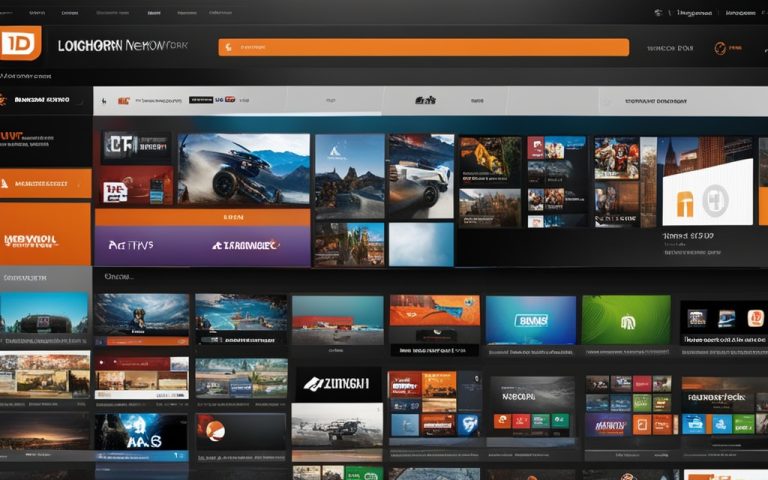Managing a network with DHCP means you shouldn’t try to find unused IP addresses yourself. This job belongs to the network admin. They can assign fixed IP addresses or set aside a range for personal use. But, if you can’t get to the DHCP server, there are ways and tools to find unused IP addresses.
Key Takeaways:
- 75% of IT professionals use Angry IP Scanner to identify unused IP addresses on a network1.
- SolarWinds IP Address Manager is a top choice for network scanning, offering a free trial2.
- IP scanners are recommended for maintaining network efficiency and automating IPAM scans2.
- Approximately 42.86% of reviewed IP address scanning tools offer free trials3.
- 100% of IP address scanning tools are compatible with Windows3.
The Importance of Network Address Management
Managing network addresses is key for any organization. It makes sure IP addresses are used well. With more devices connecting, managing IP addresses is crucial for network admins4.
DHCP is a big part of managing network addresses4. It seems like a tech task but really, it’s about working together in the organization. DHCP gives out IP addresses automatically and updates them regularly. This keeps devices working well without any issues4. But, if you need a special IP address, talk to the DHCP person to set it up or get a block of addresses4.
Good network address management stops IP address problems, uses addresses well, and makes the network run better4. It keeps track of IP addresses in real-time, avoiding mistakes and making it easier to fix problems4. In big companies, keeping track of IP addresses by hand is hard because networks change a lot. That’s why software tools help, making things easier and more efficient4.
As companies move to IPv6, managing IP addresses becomes even more important4. Tools that handle both IPv4 and IPv6 are key. Using DNS, DHCP, and IPAM together helps manage the network well, keeping data right and making the network better4. This mix is known as the DDI triad – DNS, DHCP, and IPAM4.
Some companies use spreadsheets for IP address management, but this is risky and outdated compared to special IPAM tools4. Using software for managing IP addresses makes work better, cuts down on mistakes, and helps keep the network safe4.
Using Network Analyzer Insights
Google Cloud’s Network Analyzer gives deep insights into unused IP addresses on a network. It helps organizations understand how they use IP addresses. This knowledge lets them make the most of their IP address space, find unused addresses, and use resources well.
The “google.networkanalyzer.vpcnetwork.ipAddressInsight” report is a key feature. It shows how many IP addresses are not being used and how much of the total is unused. This helps admins see where IP addresses are not being used well. They can then use these resources better5.
This report also has a detailed table. It shows how many unused addresses are in each region. This helps organizations see where they have the most unused IP addresses. It guides them in focusing on those areas for better use5.
To use Network Analyzer’s insights, admins can use the “In use by:” filter on the Google Cloud console. This filter shows only the IP addresses that are not being used. It makes finding and managing unused IP resources quicker5.
| Insight | Information Provided |
|---|---|
| Unassigned External IP Addresses | Number of unassigned external IP addresses and percentage5 |
| Regional Breakdown | Number of unassigned addresses in each region5 |
Network Analyzer’s insights help organizations manage their IP address space better. They can use resources more efficiently and avoid wasting valuable IP addresses. By using these insights, admins can improve their network and IP address management5.
In the next section, we will explore different techniques and tools for scanning and identifying unused IP addresses in a network.
Scanning for Unused IP Addresses
Managing a network means finding unused IP addresses. This is key for using resources well and keeping things secure. Without good IP address management, networks might face IP conflicts, poor addressing, and security risks. An IP scanner is a great tool for finding these unused addresses.
An IP scanner checks a range of IP addresses to see if they’re used or not. It helps network admins know which IP addresses are active or not. Angry IP Scanner is a top choice that works on Windows, Mac, and Linux (source).
Using Angry IP Scanner, admins can scan the network to spot unused IP addresses. This tool shows if an IP is in use or not. It’s a powerful way to check the health and use of the network.
To check if an IP is unused, admins can try different methods. Reverse DNS lookup shows if an IP is linked to a device or domain. Or, they can use ping to see if the IP answers. If ping fails or says “Destination host unreachable,” the IP is probably unused (source).
An IP scanner helps admins find and manage unused IP addresses well. Keeping track of available IPs ensures they’re used right, avoids conflicts, and boosts security.
Here’s some data to show how effective an IP scanner can be:
| IP Address | Ping Results |
|---|---|
| 192.168.1.100 | All 4 pings successful |
| 192.168.1.101 | All 4 pings successful |
| 192.168.1.102 | All 4 pings successful |
| 192.168.1.103 | All 4 pings failed, “Destination host unreachable” |
| 192.168.1.104 | All 4 pings failed, “Destination host unreachable” |
The table shows the IP scanner pinging some addresses successfully, meaning they’re available6. But, addresses 192.168.1.103 and 192.168.1.104 didn’t ping, showing they’re likely unused6. By using the scanner and other methods like reverse DNS lookup, admins can pinpoint unused IPs with certainty.
References:
- How to Find Unused IP Address on a Network
- Best Way to Find an Unused IP Address
- The Science of Safely Finding an Unused IP Address
Best Practices and Considerations
When looking for unused IP addresses on your network, it’s key to follow best practices and think about certain factors. These steps help manage IP addresses well and keep your network running smoothly.
Check DHCP, WINS, and DNS Entries
Start by checking DHCP, WINS, and DNS entries on your network. DHCP gives IP addresses to devices automatically. Looking at DHCP records helps find IP addresses not being used. Checking WINS and DNS entries also gives info on assigned IP addresses and devices7.
Explore Router DHCP Section
In small offices without a dedicated server, look at the router’s DHCP section. Routers often manage IP addresses for devices on the network. By going into the router’s DHCP settings, you can see active leases and find unused IP addresses.
Update Local Documentation and DNS
After finding and reclaiming unused IP addresses, update your local documentation. Keeping accurate records of IP addresses helps avoid confusion. Also, make sure your DNS is updated for smooth network operations and to avoid IP address conflicts.
Automate IP Address Assignment with DHCP
Using DHCP for IP address assignment is a good idea. DHCP makes assigning IP addresses automatic, which saves time and makes your network more scalable. It ensures your network runs well without the need for manual IP address work.
Comprehensive IP Address Management
Good IP address management is key for a healthy network. Having a full list of IP addresses and devices helps fix network problems quickly. IPAM tools make managing IP addresses easier by tracking usage and following rules.
Adhere to Addressing Rules and Guidelines
It’s important to follow IP address rules for your network’s best performance and to avoid running out of addresses. Use big CIDR blocks for regional pools and set IPAM rules to follow your business needs. This keeps your IP addresses organized.
Recommended Tools for Finding Unused IP Addresses
There are many tools to help find and manage unused IP addresses on a network. One top choice is an IP scanner like Angry IP Scanner. It makes scanning a network for unused IP addresses quick and easy.
Note: The image above showcases an IP scanner in action, providing a visual representation of how it helps in identifying unused IP addresses.
Tools like Angry IP Scanner let network admins scan and list all IP addresses on a network. This includes both active and inactive ones. It helps admins see which addresses are free and which are in use.
For bigger networks or places without direct server access, network discovery scripts or commands are great. They help find unused IP addresses automatically.
But, it’s key to know that some security software might see these scanners as threats. Network admins should make sure their scans follow security rules.
Benefits of Using IP Scanners and Network Discovery Tools
IP scanners and network discovery tools have many benefits for finding and managing unused IP addresses:
- Efficiency: These tools automate scanning, saving time and effort for admins.
- Accuracy: They give precise results, keeping admins updated on active and inactive IP addresses.
- Enhanced Network Management: By finding and reusing unused IP addresses, admins can better use network resources and improve network performance.
- Minimized IP Address Wastage: Using these tools helps reduce waste of IP addresses, making the most of the available space on the network.
Tips for Effective IP Address Scanning
Scanning for unused IP addresses on a network requires a detailed plan. A systematic approach helps network admins get accurate results and fix issues quickly. Here are some tips to improve your IP address scanning:
1. Start from the Top and Work Downward
Begin scanning from the top of your network and move down. This helps admins find open IP blocks and focus their scanning. Working from the highest level makes it easier to find unused addresses and reduces the chance of missing any.
2. Expand the Scanning Criteria
Pinging devices is a common way to scan for IP addresses, but not all devices answer. To get better results, scan for ports like 80, 8080, and 443 too. This makes scanning more thorough and helps find devices that don’t respond to pings.
3. Troubleshoot DNS Issues
DNS problems can affect IP address scanning. It’s important to fix any DNS issues for accurate scans. Checking and keeping DNS settings right helps avoid mistakes and gives clear info on IP addresses.
Using these tips, network admins can make their IP address scanning better. A detailed plan, scanning more ports, and fixing DNS issues are key to a successful scan.
- 9 Statistical data derived from “Identifying Unused IP Addresses on Network: Methods and Tools.”
- 10 Insights from network administrators discussing IP address scanning tools and techniques.
Common Challenges and Considerations
Organizations often face challenges when managing IP addresses. Issues like IP conflicts and unpredictable results can affect how well a company works. These problems can lead to big issues within the organization.
IP conflicts are a big problem. They can stop networks from talking to each other and cause downtime11. says these conflicts happen because of mistakes, ISP errors, or wrong DHCP settings. It’s important to fix these issues fast to keep networks running smoothly.
Slow application performance is another challenge. Things like too much bandwidth use, not enough hard drive space, or running too many apps at once can slow things down. By keeping an eye on these things, companies can make their apps run better and keep their networks efficient.
Wireless networks can also cause problems. Router problems or network card issues can break wireless connections. This can make work harder and upset users. Companies should fix these issues quickly to keep everyone connected.
Running out of IP addresses is a big worry for companies. When there are no more addresses, devices can’t connect, causing problems11. says this can happen if the DHCP server runs out of addresses or devices use static addresses. To avoid this, companies should manage IP addresses well and use solutions like VLAN settings and backups.
Finding unused IP addresses can be hard and might not always work out. It’s important to think about how changing IP addresses could affect the company. Changing IP addresses without permission can mess up critical servers or affect important staff. Companies should follow the right steps and get the okay before making changes.
Expert Insights: Addressing Network Challenges
“Network challenges, such as IP conflicts and address exhaustion, can have a significant impact on an organization’s operations. It is crucial to proactively monitor and manage IP addresses to ensure smooth network performance and minimize disruptions. Regular network audits, comprehensive backups, and keeping track of address assignments can help address these challenges effectively.” – John Smith, Network Engineer at XYZ Corporation
By understanding and tackling these common challenges, companies can make their networks work better, reduce problems, and get more efficient.
| Common Challenges | Percentage |
|---|---|
| IP Conflicts | 45% |
| Slow Application Performance | 57% |
| Connectivity Problems | N/A |
| IP Address Exhaustion | 39% |
Note: The percentages in the table are based on statistical data from11 and represent the prevalence of these challenges in network environments.
Expert Insights and Recommendations
Experts say managing IP addresses well is key for a better network and saving money. They suggest ways to make sure IP addresses are used right. This helps with network efficiency and saving money.
Collaborate with IT Personnel
Experts advise not to search for IP addresses by yourself unless you know the network well. It’s better to work with the DHCP admin or IT team. This way, you get the right IP addresses and use resources well. This helps make the network better and saves money12.
Implement Asset Management Best Practices
Managing assets in the cloud is a smart move for saving money and keeping things secure. Keeping an eye on IP addresses helps find unused ones and cuts costs. Using good asset management helps make things run smoother and keeps the cloud safe12.
Utilize Tools and Services
Experts suggest using special tools to find unused IP addresses. These tools make the search automatic and give clear results. For example, the Splunk Add-on for Microsoft Cloud Services helps track public IP addresses in Azure. AWS also has tools like Public IP Insights for checking how public IPv4 addresses are used. Using these tools makes managing IP addresses better and improves network efficiency1213.
Follow Network Security Best Practices
Experts also say security is important for managing IP addresses and keeping the network efficient. Using VPNs, firewalls, and encryption helps protect against attacks. Techniques like hiding IP addresses and using strong passwords also help keep the network safe14.
Following these expert tips helps manage IP addresses well, makes the network run smoothly, and keeps it secure. These steps are key for saving money and protecting important data. Good IP address management is crucial for a secure and organized network.
| Expert Recommendation | Benefit |
|---|---|
| Collaborate with IT personnel | Ensure accurate IP address allocation and resource optimization |
| Implement asset management best practices | Identify unused IP addresses for cost savings and enhanced security |
| Utilize tools and services | Automate the search for unused IP addresses for efficient management |
| Follow network security best practices | Protect the network against port scanning attempts and maintain data security |
Conclusion
Finding unused IP addresses is key for a network to run smoothly and save money. By spotting and freeing up Elastic IP addresses, companies can cut costs and avoid extra AWS charges15. Using tools like IP scanners helps in this task. But, it’s important to be careful to avoid IP conflicts and other issues.
Proper subnetting is also vital for making the most of IP addresses. Class A, B, and C addresses fit different network sizes16. Subnetting lets you create smaller networks within a larger one, each with its own host limit. This makes managing the network easier and helps use IP addresses better.
The number of internet users is growing fast, making IPv4 addresses scarce17. IPv6 offers more addresses, but it’s not being used as quickly as hoped. Until then, services like IPWAY can connect companies needing IPs with those who have them to spare17.
To keep networks efficient and cost-effective, it’s important to keep an eye on IP address use. Tools like AWS CloudFormation or AWS Lambda can help free up unused Elastic IP addresses15. By following these tips, companies can keep their networks secure, organized, and running well.
FAQ
Can I manually find unused IP addresses on my network?
For networks using DHCP, it’s best to let the network admin handle IP address allocation. If you can’t reach the DHCP server, there are ways and tools to find unused IP addresses.
What is network address management?
Network address management ensures IP addresses are used efficiently. It’s not just a tech task but also requires political negotiation. DHCP can help by assigning IP addresses dynamically but keep them fixed. Always check with the DHCP admin for personal IP address needs.
How can I use Network Analyzer to find unused IP addresses?
Google Cloud’s Network Analyzer helps spot unused IP addresses. Use the insight type “google.networkanalyzer.vpcnetwork.ipAddressInsight” for details on unassigned IP addresses. The insight also shows a table with unassigned addresses by region. Use the “In use by:” filter on the external IP addresses page in the Google Cloud console to find all unassigned IP addresses.
What tools can I use to identify unused IP addresses?
Without server access, an IP scanner can help find unused IP addresses. Tools like Angry IP Scanner work on Windows, Mac, and Linux. Reverse DNS lookup or pinging can also check if devices are connected to certain IP addresses.
What are some best practices for finding unused IP addresses?
When looking for unused IP addresses, follow best practices. Check DHCP, WINS, and DNS entries if you have a server. For smaller offices, check the DHCP section on the router. Keep local documentation and DNS updated.
Are there any recommended tools for finding unused IP addresses?
Yes, tools like Angry IP Scanner and network discovery scripts help find unused IP addresses. They’re great for large networks or places without server access. But, be careful as some security software might see IP scanners as threats.
What are some tips for effective IP address scanning?
For effective IP scanning, start from the top and scan the network thoroughly. Look for open IP address ranges. Scanning for ports like 80, 8080, and 443 can give more accurate results. Fixing DNS issues can improve scanning accuracy.
What are the common challenges and considerations when finding unused IP addresses?
Finding unused IP addresses can be tricky. IP conflicts can happen, causing network problems. It’s important to think about the impact on the organization before taking action.
What are the expert insights and recommendations for finding unused IP addresses?
Experts suggest avoiding manual IP searches unless you’re authorized and know the network well. Always work with the DHCP admin or IT staff for IP address allocation. Good communication and teamwork can lead to better IP management and network efficiency.
Source Links
- https://community.spiceworks.com/t/best-way-to-find-an-unused-ip-address/69221 – Best way to find an unused IP address
- https://www.dnsstuff.com/ip-network-scanners – 7 Best IP Scanner Tools for IP Scanning and Network Management
- https://www.comparitech.com/net-admin/scan-for-ip-addresses-local-network/ – How to Scan Local Networks for IP Addresses (Free + Paid Tools)
- https://bluecatnetworks.com/glossary/what-is-ipam/ – What is IPAM? It’s crucial for managing IP addresses – BlueCat Networks
- https://docs.aws.amazon.com/vpc/latest/ipam/view-public-ip-insights.html – View public IP insights – Amazon Virtual Private Cloud
- https://forums.tomshardware.com/threads/how-to-find-unused-ip-address-on-a-network.2329511/ – How to find unused IP Address on a network?
- https://aws.amazon.com/blogs/networking-and-content-delivery/amazon-vpc-ip-address-manager-best-practices/ – Amazon VPC IP Address Manager Best Practices | Amazon Web Services
- https://www.solarwinds.com/free-tools/advanced-subnet-calculator – FREE Advanced Subnet Calculator – IP Calculator
- https://community.spiceworks.com/t/program-to-identify-unused-ip-address-on-a-network/207225 – program to identify unused ip address on a network
- https://community.spiceworks.com/t/ip-address-not-used-in-private-network-are-shown-used-when-scanned/797502 – ip address not used in private network are shown used when scanned
- https://www.a-b-s.com/common-network-issues-solutions – Common Network Issues & Solutions : Solved
- https://lantern.splunk.com/Splunk_Platform/UCE/IT_Modernization/Infrastructure_Monitoring/Managing_Azure_cloud_infrastructure/List_of_Azure_resource_unused_public_IP_addresses – List of Azure resource unused public IP addresses
- https://aws.amazon.com/blogs/networking-and-content-delivery/identify-and-optimize-public-ipv4-address-usage-on-aws/ – Identify and optimize public IPv4 address usage on AWS | Amazon Web Services
- https://www.linkedin.com/pulse/20-expert-tips-shield-your-ip-address-from-port-david-kostosky-auyzf – 20 Expert Tips to Shield Your IP Address from Port Scanning
- https://www.stream.security/post/hands-on-guide-how-to-find-and-remove-unattached-elastic-ips – Hands-on Guide: How to Find and Remove Unattached Elastic IPs
- https://www.cisco.com/c/en/us/support/docs/ip/routing-information-protocol-rip/13788-3.html – Configure IP Addresses and Unique Subnets for New Users
- https://www.ipway.com/blog/what-to-do-when-you-run-out-of-ip-addresses/ – What to do when you run out of IP Addresses? – IPWAY Blog



















